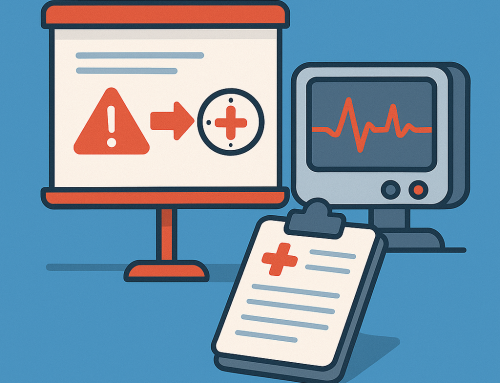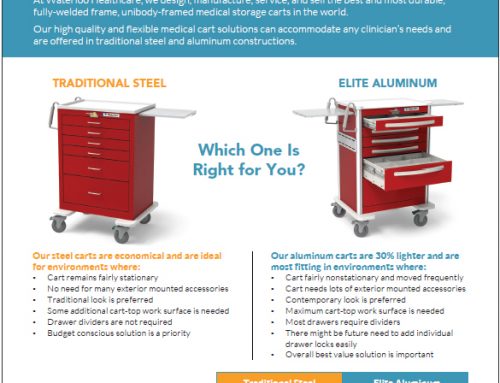Healthcare environments require a healthy level of cleanliness and functionality of medical equipment, but it’s not just about appearance. Cleaning carts is a critical component of patient safety and infection control. Medical carts serve as mobile command centers throughout hospitals and clinics, so maintaining a specific cleaning protocol will ensure that they continue performing reliably while meeting healthcare standards.
Healthcare carts are designed for long-lasting functionality. However, proper cleaning techniques can significantly extend their lifespan and maintain their professional experience. That’s why we’ve compiled a list of the right cleaning methods, appropriate products, and potential pitfalls that can help healthcare facilities avoid problems and protect their investments for many years to come.

Medical Cart Construction and Cleaning Requirements
Medical carts are precision-engineered and designed to withstand constant use and abuse. They frequently transport vital tools throughout challenging conditions in healthcare environments. Most quality medical carts are comprised of aluminum and steel, finished with powder coating, and specialized components.
The materials used in medical carts are chosen for their durability and resistance to cleaning agents, but they’re not indestructible. Some cleaning materials cause damage while cleaning. It all depends on how well the equipment is properly maintained over time.
Recommended Cleaning Products and Solutions
Because healthcare facilities rely on cleaning products that effectively eliminate pathogens, cleaning products have to strike a balance between sanitizing and protecting equipment. Standard household cleaning products are an excellent starting point for routine cart maintenance because they are typically gentle but effective. Below is a list of potential cleaning agents perfect for your healthcare cart.
- Diluted bleach solutions: The best diluted bleach solutions contain up to 10% bleach and offer powerful disinfection capabilities. The relatively low bleach concentration is effective for pathogen elimination. It doesn’t have the same harsh effects as full-strength bleach, which can damage finishes and compromise structural integrity over time.
- Great healthcare environment cleaning products: Healthcare-approved cleaning products usually have superior performance and are convenient. For example, CaviWipes provide hospital-grade disinfection in wipe form, making them ideal for quick cleanings between procedures or during busy shifts. These wipes are designed to disinfect while maintaining a gentle finish on equipment surfaces.
- Sani-Cloth Plus: These wipes are EPA-registered disinfectants that kill pathogens in a relatively short time frame. They are specifically designed for medical equipment, which means they’re reliable for healthcare professionals to use during demanding schedules.
- Clorox Bleach Germicidal Wipes: Like the other wipes on this list, these provide a trusted cleaning method that combines bleach with pre-moistened wipes. They have reliable dilution ratios, eliminating the guesswork while ensuring effective disinfection.
- Micro Kill AF2: The Micro Kill AF2 provides alcohol-free disinfection, perfect for any facility looking for alcohol-free cleaners. It offers a wide variety of antimicrobial activity that’s compatible with sensitive electronic components, such as those found in medical carts.
- PDI Super Sani-Cloth: Finally, the PDI Super Sani-Cloth represents the gold standard in healthcare disinfection wipes. They offer rapid sanitation times and are highly compatible with a wide range of medical equipment services. Because of their reliability and effectiveness, healthcare professionals worldwide use them.
Proper Cleaning Techniques for Different Cart Components
Effective medical care cleaning means taking a systematic approach to address different components and materials. Starting with the cart’s exterior surfaces, use gentle, circular motions to clean all visible surfaces. Pay close attention to frequently touched areas, such as handles, drawer pulls, and work surfaces.
Clean all cart services from top to bottom to prevent recontamination of already cleaned parts. Debris naturally falls downward, and maintaining a natural cleaning flow can save time and cleaning materials.
For textured surfaces, usually those with accumulated debris, allow cleaning solutions to soak for as long as the manufacturer recommends. Disinfectants need time to achieve their full antimicrobial effectiveness and to break down stubborn contaminants.
The interiors of drawers and storage compartments require special attention. Because of their storage supplies, these areas often harbor more debris and contaminants. Remove all items before cleaning. Wipe them down thoroughly to ensure that they are completely dry before restocking to prevent moisture-related issues.
Cleaning Electronic Components Safely
Because modern medical carts are becoming increasingly electrically efficient, the electronic components within them require frequent maintenance. Keypads, proximity readers, and display screens need regular cleaning and often specific techniques to prevent damage.
Use the same recommended cleaning products for electronic components, but apply them to cleaning clothes rather than directly to the equipment. A cloth can often prevent excess moisture from entering electronic housings, which could cause damage.
For keypads and touch screens, use gentle pressure and avoid excessive scrubbing. Excess pressure could negatively affect protective coatings or sensitive surfaces. Pay extra attention to the spaces between keys and buttons, which often accumulate contaminants.
Proximity readers and sensors are sensitive to both physical damage and chemical residues, so they often require extra care. Clean these components last to ensure that they stay completely dry and functional before the cart is returned to service.
Critical Cleaning Mistakes to Avoid
Knowing what to avoid is equally as important as knowing proper cleaning techniques. Several common mistakes can damage medical carts, and avoiding them will ensure a longer lifespan.
Avoid cart washes or autoclave systems. These systems use high-temperature, high-pressure cleaning methods that damage finishes, warp structural elements, and could even compromise electronic components. Medical cards are intricate, which means they cannot withstand extreme cleaning conditions.
Avoid dishwashers for cleaning cart components. Dishwashers pose similar risks to standard cart washes and autoclave systems: high temperatures, harsh detergents, and extended water exposure. The combination of these factors usually causes irreversible damage to cart materials and finishes.
Avoid using full-strength bleach for all cart cleaning. While it is an effective disinfectant, using an undiluted bleach solution can create corrosive problems and compromise structural integrity over time. It’s best to stick to a 10% dilution ratio.
Maximizing Cart Lifespan Through Proper Care
It should come as no surprise that the proper cleaning techniques directly impact medical care longevity and performance. Carts that receive proper care can serve healthcare facilities for decades.
Regular cleaning prevents the accumulation of corrosive substances that could damage cart finishes or compromise structural integrity. The longer this chore is left undone, the greater the risk to your cart wearing out. However, by removing contaminants, health care facilities protect their investments and ensure reliable performance for years to come.
Proper cleaning also maintains a professional appearance. Well-cleaned and maintained carts reflect positively on any facility and increase patient confidence.
Maintaining Carts for Years to Come
Maintaining medical carts shouldn’t be a lengthy or difficult process. Proper cleaning protocols can save healthcare facilities time and money, avoiding common mistakes to maintain the highest standards of cleanliness and functionality.
Medical carts should be cleaned after each use or patient encounter to maintain proper disinfection standards. How often a facility deep cleans depends entirely on usage intensity. The key to staying up to date on cleaning comes down to developing consistent protocols and ensuring that all staff members understand and follow proper procedures.
With over 50 years of manufacturing expertise, Waterloo Healthcare stands ready to support your facility’s equipment needs with durable, customizable medical carts built to last. Contact our team today to learn how our solutions can optimize your healthcare environment’s efficiency and organization.






